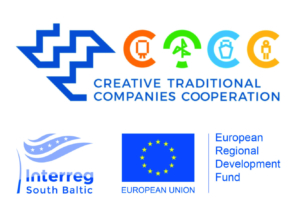Creative Audit Tool
Understanding the state of creativity, the creative potential of staff and the organisation is essential when planning as to which creativity tools to apply and to what extent. An audit tool can be used to support this at the beginning of the process for interim monitoring and at the end of the process (or ‘cycle’, as we should remember that creativity is not a one-time action but a regulated one). Therefore, an end evaluation (audit) is rather an end evaluation of a cycle that iterates to other applications of the creative tools in this cyclic process.
One of the main outputs of the CTCC project is the Creative Audit Tool which aims to improve selected traditional SMEs’ innovation performance with inputs from selected creative industries (CI). This tool is used for mediating cross-sectoral innovation process and involves a process-based approach on how challenges & problems in traditional SMEs, who are less innovative, can be solved by integrating creative knowledge and skills and what positive solutions can be developed.
Small and medium enterprises are the backbone of many South Baltic Sea Region’s economies, being the main contributors to employment. SMEs tend to be informal, young, have less publicly available information, and operate in unfamiliar sectors, all of which results in higher information asymmetries and financial risk.
The integrating of creative knowledge in the traditional SME sector can bring a new source of business value to the companies and become a key to innovation. The concept of ‘creative skills’ can be applied to critical thinking and problem-solving ability, both of which enabling people to see and deal with complex problems and constraints in different ways.
The Challenges which SMEs can tackle the most effectively using the creative approach are:
- Leadership
- Culture
- Strategy
- Strategy execution
- Building an “A” team
- Making the business stand-out
- Putting your employees first
- Systems and processes
- Productivity
- Measuring performance
- Political changes
But how to understand to what extent creativity should be applied and if the chosen solution is innovative enough?
How to measure creativity?
There exist four different ways to assess creativity, each designed for different settings:
- Measuring How Creative a Person Is – The Guilford Model
- Measuring How Creative a Work Is – The Taxonomy of Creative Design
- Measuring Creative Work Against a Program – The Requirements Model
- Measuring the Social Value of Creative Work – Csikszentmihalyi’s Model
Notably, in each of these cases, what we mean by “creative” changes a little. Sometimes “creativity” refers to divergent production (how much one produces, or how varied it is). Sometimes “creativity” refers to novelty in form. Understanding this—understanding the reason for measuring creativity or the kind of creative work one aims to assess—is the first step to demystifying the creative space.
More details about the Development of the Creative Audit Tool you can find in the report below.
Check the tools provided in the report below. They can help you start and implement Creative Auditing in your company.
How creative are you?
Business creativity is all about finding fresh and innovative solutions to problems and identifying opportunities to improve the way that we do things. As such, anyone can be creative, just as long as they have the right mindset and use the right tools. This test helps you to think about how creative you are right now.
